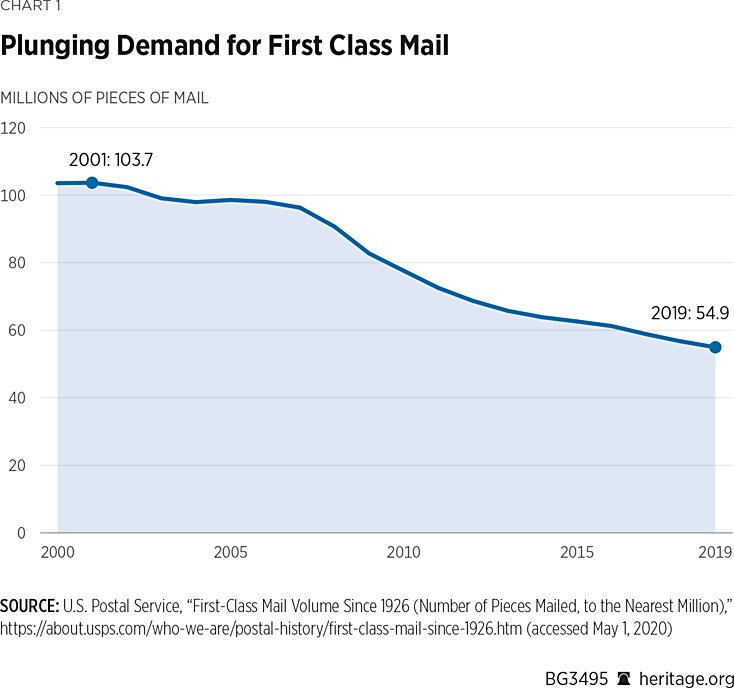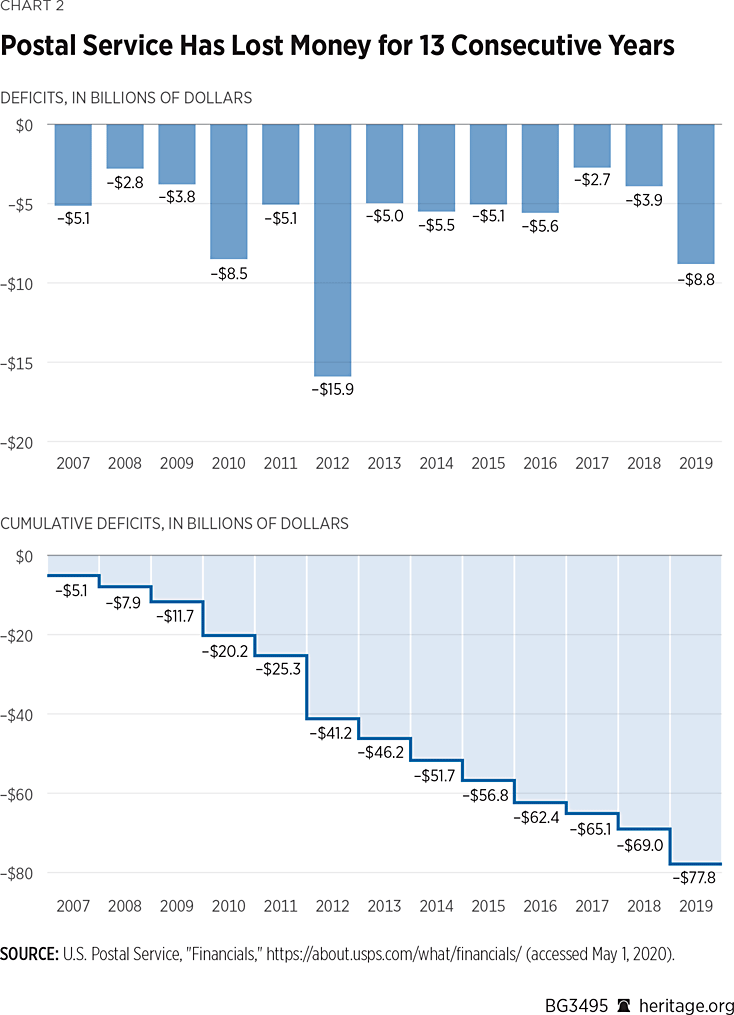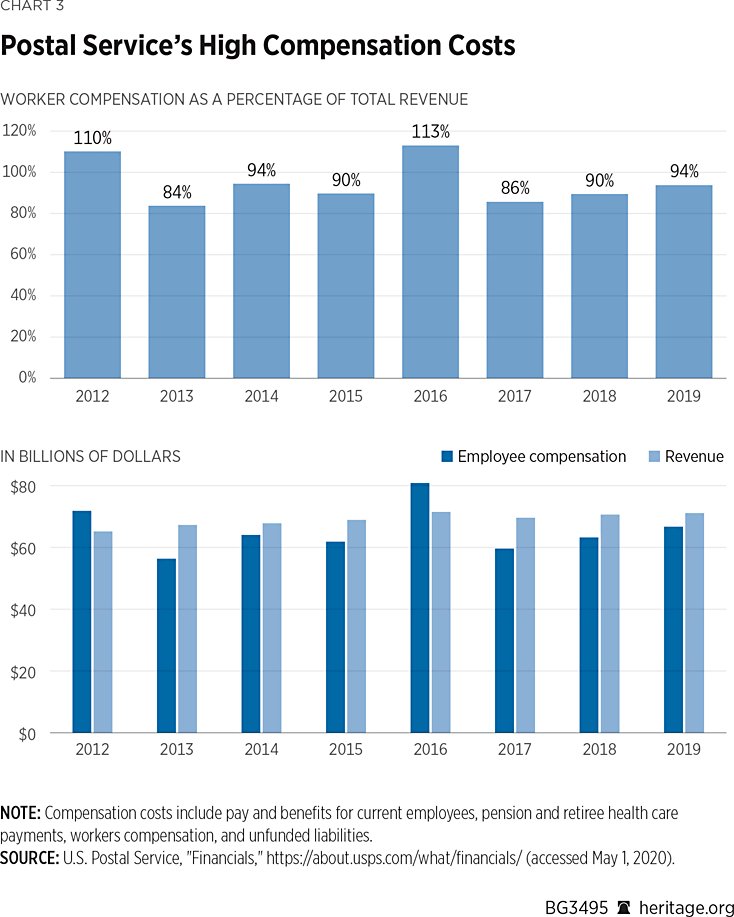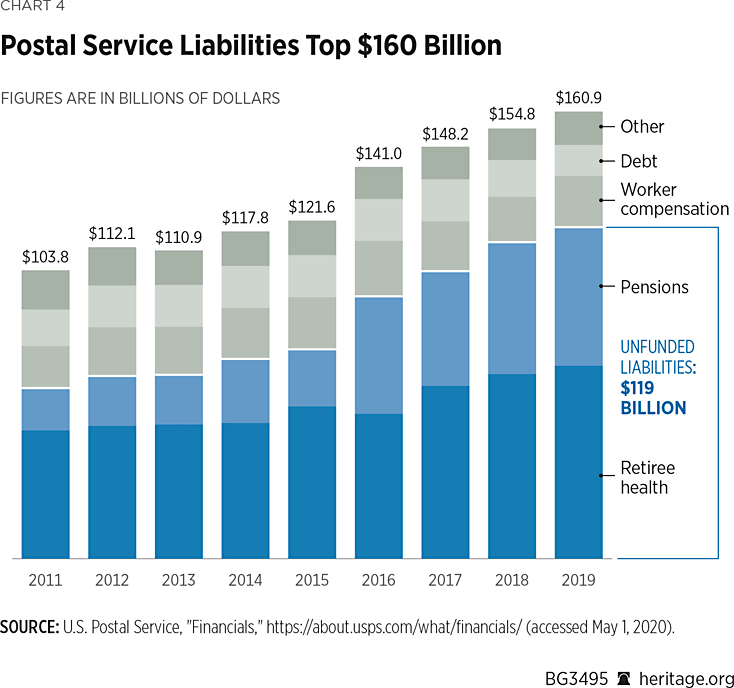The United States Postal Service (USPS) was long a dominant force in American life. In the past, it was essential to enabling communication among family and friends across the country. Businesses relied on it to contact suppliers and customers, making interstate commerce itself possible. Those days are long gone.
The USPS no longer holds this position. E-mail, texting, and social networking have largely replaced letter mail. Business-to-business correspondence is virtually all electronic. Consumers pay most bills online and are receiving an increasing portion of their bills electronically. As a result of these changes, the use of letter mail has shrunk dramatically. First-Class mail volume has plunged by almost 50 percent since 2001.REF With the exception of package delivery, every category of mail is shrinking.

Even the composition of mail is moving away from the sort of personal communication for which the service was originally designed. In 2005, the volume of First-Class mail (such as letters) was only slightly below that of cheaper mass mailings (such as advertisements).REF In 2019, the volume of marketing mail exceeded First-Class mail by 38 percent.REF
The Postal Service remains a substantial business. According to the USPS website, “If [the USPS] were a private sector company, the Postal Service would rank 44th in the 2019 Fortune 500.”REF Yet, if the USPS were a private-sector company, it would have entered Chapter 11 bankruptcy proceedings years ago as a result of 13 straight years of operating losses. It ran a deficit of $8.8 billion in 2019, with a cumulative $78 billion deficit since 2007. In 2019, the USPS predicted that it would run out of cash by 2024, leaving behind about $120 billion in unfunded pension and other post-employment benefit liabilities that would have to be paid by other federal workers or U.S. taxpayers.REF

Coronavirus Accelerates Postal Collapse
This grim prognosis for the Postal Service’s finances worsened considerably with the arrival of COVID-19 in the United States. With the U.S. economy virtually frozen, mail volume has plummeted. Mail demand is down by 30 percent so far this year, and the USPS projects it could drop over 50 percent by years’ end. The Postal Service does not expect to fully recover, even after the pandemic has ended: It projects long-term mail volume to be only 74 percent of its pre-virus levels. The USPS knows that once customers leave the post office, they often do not come back.REF
The impact on USPS finances will be substantial. The USPS has stated that the pandemic will reduce its revenue by $13 billion this year, and by $54.3 billion over the next 10 years. This would be far too much for the USPS’s already failing finances to absorb. By USPS reckoning, it will run out of money before the end of September 2020 and could then be forced to stop operations.REF
Facing these chilling prospects, in early April the Postal Service Board of Governors appealed to Congress for $75 billion in federal aid. Of this, $25 billion taxpayer dollars would be handed over to the USPS without strings. Another $25 billion would be provided in the form of grants for “shovel-ready” projects to upgrade the Postal System’s physical infrastructure, including vehicles and facilities. The final element would be $25 billion in unrestricted borrowing authority from the U.S. Treasury.
But President Donald Trump has scorned this proposal.REF He stated that he would not sign any bailout for the Postal Service unless certain conditions are met. The President is right: A massive bailout would not solve the problems facing the USPS. Instead, a bailout would exacerbate the USPS’s problems by allowing Congress to put off real reform.
There are also reasons to doubt the bankruptcy timeline put forward by the USPS. Postal data from the first few weeks of April 2020 do point to a substantial reduction in mail volume, but there is also a substantial increase in package deliveries. The net result will almost certainly be a loss of revenue, yet not necessarily a large enough loss to deplete the organization’s resources this year, let alone by September.REF The USPS has also failed to provide sufficient public documentation to back up its financial assertions, relying instead on press releases and private briefings to Congress. Regardless, reforms to the service are essential no matter the actual timeline for a possible USPS bankruptcy.
The Postal Service’s situation is grimly serious, but it is not a bolt out of the blue stemming from the coronavirus pandemic. Rather, the USPS was heading toward a financial collapse long before COVID-19 ever left China; the only question was when that collapse would occur. The Postmaster General, after all, had already warned of a 2024 failure.
The COVID-19 crisis accelerated that timeline, moving Postal D-Day forward. A bailout might put off that reckoning day for a short time, but would ultimately solve nothing. Congress must ensure that the USPS is reformed so that it can operate on a financially sustainable and competitive basis.
Liberating the Postal Service and Letter Mail
The universal service obligation (USO) is a set of mandates governing the USPS by law, requiring it to provide mail service to every household in America, including remote rural addresses, at affordable prices. In theory, this service is paid for by profits generated by privileges enjoyed by the USPS, which include a monopoly over letter mail and sole access to mailboxes.
This mandated cross-subsidy scheme may have worked decades ago, but is unsustainable in today’s marketplace, in which digital communications have eliminated the Postal Service’s ability to generate monopoly profits. At the same time, digital alternatives have reduced dependence on the Postal Service for communication, especially in rural areas.
The exact requirements of a USO are contested, spanning from geographic scope to range of products, access to services and facilities, delivery frequency, and affordable and uniform pricing, among others. Rather than focusing on providing a reasonable and affordable level of service under the USO, legislators often take an overly expansive view, such as interpreting the USO to require delivery six days a week, leading to unnecessarily high costs. The USO should be redefined and narrowed, or even phased out completely along with the postal monopolies. Ending the USO (and postal monopolies) would also enable the federal government to spin off the government postal service as a private company, which has taken place with great success in Germany and the United Kingdom.REF
While the USPS monopoly on mail delivery is worth billions of dollars,REF it comes at a steep price: dependence on Congress. Private companies have the freedom to adapt to the changing needs of customers and workers, along with economic reality.
Eliminating Barriers to Streamlining Services. While setting the Postal Service free to manage its own operations would be the ideal outcome, if Congress is determined to maintain federal control over the USPS, it should at least allow it to make the operational changes necessary to operate sustainably and competitively in today’s world. A multitude of operational reform ideas are available, each of which would move the USPS closer to the goal of sustainability, including:
- Reduced frequency of home deliveries from the current six per week to five or fewer. Under limits imposed in appropriations riders each year, the USPS is required to deliver mail to all addresses at least six days per week. Such frequency, however, may not be worth the cost, since consumers generally already use express mail or e-mail for time-sensitive messages. The advantage of postal delivery is not speed, but other factors, such as geographic coverage. According to the 2018 report of President Trump’s Task Force on the Postal Service, elimination of Saturday mail could save as much as $1.5 billion annually.REF
- Different methods of delivery (away from door-to-door service). The marginal cost of delivering directly to each mailbox can be quite high, especially in rural areas. Allowing the USPS to utilize clustered mailboxes to cover a neighborhood or a larger geographic area, where appropriate, would provide much-needed savings.
- Consolidated or reduced hours of operation for retail locations. With shrinking mail volume, the USPS requires fewer facilities. For instance, many post offices (especially in rural areas) are badly underused, serving only a handful of customers. Constraints imposed by Congress make it difficult to close or consolidate these underused facilities, with the USPS banned entirely from closing a post office for losing money.REF
- Better developed Postal Service real estate. The USPS is one of the largest commercial real estate owners in America, with 900 million square feet of real estate, often in prime downtown locations. Much of this is underutilized. More productive use of this valuable real estate, such as by allowing new residential buildings to rise above ground-floor post offices, could create a valuable new source of private-sector income.REF
Many of these proposals could be implemented now, but have been blocked by political or labor union opposition. The Administration should insist on eliminating barriers to these reforms before providing any aid.
The USPS, Amazon, and Package-Delivery Rates
Not all potential changes to the USPS are created equal. In his April 24 comments, President Trump called on the USPS to increase its rates for package delivery, saying: “[T]he post office should raise the price of a package by approximately four times.”REF This amount is based on the assertion that shippers pay exceedingly low amounts for package deliveries. President Trump was referring to Amazon’s deal with the Postal Service, under which the USPS carries almost half of Amazon’s deliveries at negotiated rates that are out of sight of public scrutiny.
While it is questionable whether negotiated package rates reflect the operational costs of delivery, dramatically higher prices could mean less revenue for the USPS, not more. The Postal Service has no monopoly on the package shipping market, and it is far from being a dominant carrier. Instead, it runs behind the United Parcel Service (UPS) and FedEx in the package-delivery marketplace. A massive shipping rate increase could cause Amazon to turn to UPS or FedEx. Or, even worse from the USPS point of view, Amazon could deliver more of its own packages.REF While letter mail volume has been in a free-fall, the package market has been growing rapidly. Packages are now responsible for over 30 percent of postal revenue.REF The potential loss of the Amazon deal could be a critical blow to the USPS.
It is possible that the USPS is currently charging prices for package shipping that are unsustainably low. A Treasury Department task force report on the USPS noted that the service seems to set package rates with a goal of maximizing volume rather than revenue.REF Similarly, UPS has argued in federal court that USPS package revenue is artificially low relative to its share of expenses.REF Yet this does not prove that the USPS shipping agreement with Amazon is unprofitable, or that the USPS could increase its prices significantly without a catastrophic loss of package customers.
If the USPS is indeed prioritizing the volume of package deliveries over the revenue that it needs to survive, that would point to misaligned incentives and poor management. However, the USPS also has an obligation to honor agreements made in good faith with customers, such as Amazon. Any changes to USPS shipping rates should be regulated by the Postal Regulatory Commission based on allocated costs, rather than political leverage.
Congress should demand that the Postal Regulatory Commission audit postal shipping rates and agreements to help add clarity to this important subject.REF The audit should also include an analysis of pricing for non-competitive postal services, such as First-Class and Marketing mail.
Unsustainable Burdens: Employee Compensation and Pensions
A key area of needed reform is postal employment pay and benefits. The USPS employs about 630,000 people (about 500,000 of whom are career employees), including mail deliverers, sorters, and post office clerks, making it one of the largest employers in the country.REF The USPS employs more workers than the Departments of Defense, Commerce, Justice, Labor, Health and Human Services, Education, State, Treasury, and Energy.REF In fact, the USPS is larger than the entire active-duty U.S. Army.REF
More than three-quarters of Postal Service expenses, and 86 percent of its revenues, go to compensation for its workers.REF Total compensation costs in 2019 averaged $97,588 per worker.REF This compares to average private-sector compensation of $69,440 in 2019.REF Yet, the USPS has limited control over its compensation costs because Congress’s hold over USPS operations makes it difficult for the USPS to implement a more competitive and sustainable compensation system.

Like many governments and a declining number of private companies, the USPS provides substantial pension and health benefits to its retired workers. These benefits are part of workers’ total compensation package, such that workers are willing to accept lower pay in return for the promise of future compensation in retirement.
However, the USPS is not actually paying for those future benefits. That is a big problem. Not only is the money not there when workers retire, but the funds never have the chance to earn a positive rate of return over time. According to the National Association of State Retirement Administrators, 63 cents of every dollar in benefits come from investment earnings.REF Thus, when the bills come due, the USPS owes both the amounts it failed to pay, plus decades’ worth of interest that it never earned.
Even though the USPS is required by law to pre-fund its retiree and health benefits, over just the past 10 years, it has failed to pay an estimated $47 billion in retiree health benefit contributionsREF and at least $6 billion in pension contributions.REF All told, the USPS faces roughly $120 billion in unfunded liabilities for retiree health and pension benefits.REF This is all in addition to more than $41 billion in debt, workers compensation, and other liabilities.REF

Private-sector companies that provide pension benefits are also required to pre-fund their benefits. The difference, however, is that they face significant consequences if they fail to make contributions, including financial penalties and the possibility of their plan being terminated or taken over by the Pension Benefit Guaranty Corporation (union plans are largely exempt from such consequence, however).REF Moreover, the USPS is part of the same federal retirement programs as all other federal agencies (the Federal Employee Retirement System (FERS) for workers hired after 1986, and the Civil Service Retirement System for those hired in 1986 or earlier), and no agency is allowed to simply skip retirement contributions.
Retiree health benefits, although increasingly rare among private employers, are a little different and companies are not usually required to pre-fund them. As opposed to guaranteed benefits, employers typically have the flexibility to adjust or even eliminate those benefits based on their finances and benefit costs.
In contrast, the USPS’s retiree health benefits carry the same level of guarantee as pension benefits, which is why Congress passed a law requiring the USPS to pre-fund them.REF Requiring employers to pre-fund guaranteed retirement benefits makes sense because those benefits are a form of compensation, and when companies fail to fund their promised benefits, they are effectively stealing from workers. However, just as private companies can alter their retiree health benefit plans, the USPS should be able to do the same. If it is no longer financially possible for the USPS to pre-fund retiree health benefits, it would be better for the USPS to end or limit current and future accruals or to give workers the option to contribute out of their own paychecks.
Additionally, just as private companies are allowed to invest their pre-funded benefits in assets that provide competitive returns, the USPS should be allowed to do so for its retiree health contributions. A bipartisan bill, H.R. 2553, would allow the USPS to invest 25 percent of its health benefits fund in exchange-traded index funds, instead of exclusively in U.S. Treasuries that provide paltry returns.REF Investing in indexed assets that provide higher returns would help to reduce the amount that the USPS is required to contribute to pre-fund its health benefits. Such action should not include any federal taxpayer guarantee of invested funds.
The problem with the USPS, however, is that as long as it is forced to remain part of the federal employees’ retirement systems and yet fails to make required contributions, its retirement shortfalls will ultimately fall on other federal workers or federal taxpayers (or some combination of the two). Congress already increased the pension contributions paid by more-recently hired federal workers to the FERS, from 0.8 percent to 4.4 percent for workers hired after 2013 to improve the financial status of its retirement system. Missed contributions from the USPS will weaken the FERS system and could lead to further increases for current and future federal workers, or a possible increase in taxpayer costs to fund the system.REF The USPS’s unfunded retiree health care benefits will almost certainly fall on taxpayers as there is no fund for non-postal federal employee retirement health benefits to which Congress could require current non-postal workers to pay higher contributions.REF
The House voted in February to remove the requirement that the USPS pre-fund its retiree benefits, but that would only mask the USPS’s liabilities and increase future taxpayer burdens. Instead of trying to paper over the USPS’s shortfalls by removing the requirement that it actually fund the compensation it offers its workers, Congress should give the USPS more authority to reform its compensation system, bringing it more in line with the private sector so that the USPS can become viable and self-sustaining.
Compensation reforms should include:REF
- Eliminating retiree health benefits for newly hired workers;
- Making retiree health benefits optional for existing USPS employees and requiring those who want to participate to make contributions to the system;
- Investing a portion of USPS retiree health benefit funds in exchanged-traded index funds;
- Shifting away from a defined-benefit pension, toward a larger defined-contribution system with options for existing workers to keep their pensions;
- Bringing paid leave in line with the private sector and potentially shifting to a more flexible paid-time-off (PTO) system; and
- Ensuring that pay structures align with the private sector so that the USPS neither wastes funds by overcompensating nor fails to attract and retain workers by undercompensating.
Reform Is Essential
“Saving” the USPS requires more than patching over structural-loss drivers with taxpayer money. Aid, if provided, must be conditioned on essential reforms of the USPS and removal of barriers to these reforms by Congress. Congress should:
- Phase out the USO and end the USPS’s letter-delivery and mailbox-access monopolies. The USPS’ service mandate and its legally granted monopolies are outdated and harmful. Ending the USO and revoking monopoly status would enable Congress to spin off USPS as a private company, as Germany and the United Kingdom have done with great success with their own previously government-run postal services. Setting the Postal Service free to manage its own operations carries the greatest promise for a sustainable and competitive USPS.
- Eliminate barriers to operational reforms that would save the USPS money. Short of Postal Service privatization, Congress should allow the Postal Service to adopt sensible operational reforms. The USPS should be able to adjust the frequency and method of delivery, consolidate its retail facilities and determine their hours of operation, and manage its own real estate assets to leverage their full potential.
- Preserve the requirement that the USPS pre-fund its retiree benefits, but give the USPS the authority to make its retirement program sustainable. USPS workers are included in the same pension and retiree health benefit program as other federal workers, despite the USPS operating under a mandate for self-sustainability. When the USPS fails to make pension and retiree health benefit contributions, this exposes other federal workers and taxpayers to those costs. If the USPS cannot pre-fund its retiree benefits, it should be allowed to alter future benefit accruals and also to invest its prefunded benefits in more competitive investments.
- Give the USPS the authority to reform its compensation system to align more closely with private-sector compensation systems. Compensation reforms should include shifting from a defined-benefit pension to a defined-contribution system; eliminating retiree health benefits for newly hired workers while asking current USPS employees to make contributions towards their health benefits, if they wish to keep them; and shifting to a more flexible PTO system with the amount of paid leave more closely in line with benefits provided in the private sector.
- Demand an audit of postal shipping rates and agreements to clarify whether USPS package-shipping rates reflect the actual costs to the USPS of delivering packages. USPS package shipping, which operates in competitive markets, should reflect the actual marginal costs of the service, without cross-subsidies from letter mail and other services for which the USPS has a statutory monopoly. Congress should demand that the Postal Regulatory Commission audit postal shipping rates and agreements, to include an analysis of pricing for non-competitive postal services, such as First-Class and Marketing mail.
Ultimately, the Postal Service must be untethered from political control and allowed to implement needed reforms, to enable it to operate sustainably and competitively. If that does not happen, any bailout will merely beget more bailouts—and still would not save the Postal Service for the long run.
Romina Boccia is Director of the Grover M. Hermann Center for the Federal Budget, of the Institute of Economic Freedom, at The Heritage Foundation. David A. Ditch is Research Associate in the Hermann Center. James L. Gattuso is Senior Research Fellow in Regulatory Policy in the Thomas A. Roe Institute for Economic Policy Studies, of the Institute for Economic Freedom. Rachel Greszler is Research Fellow in Economics, the Budget, and Entitlements in the Hermann Center.



